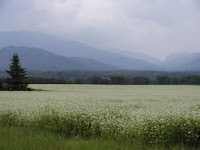I'm a painter, too (one of my still life paintings is to your left), and I remember my favorite painting teacher once saying this:
What's around the object in a painting is as important as the object itself.
Artists call this area around the object "negative space." Whenever I got stuck painting the object itself, I trained myself to look at the negative space and see if putting attention on that would bring the object into focus. It often did.
And this painting technique taught me a lot about how the inner story and the outer story work together as you're writing a book.
Snippets ("islands") let the inner story evolve organically
In the post above, I talked about Kenneth Atchity's book, A Writer's Time, and Vivian Gornick's The Situation and the Story. They gave me excellent ideas to improve my book-writing method. I became skilled at pacing myself, writing in snippets ("islands"), and--most of all--restraining my need to organize until I had exhausted the random side of my writing self.
This random side produces the inner story, the emotional juice, the creative leaps in literature. Just like the negative space in a painting, it usually isn't the thing a writer focuses on. Luckily, it comes out organically if you write in snippets.
You'll probably be most familiar with your book's outer story. It's the structure of your story (the framework, the building).
The inner story is the life lived inside the events. It's what we remember long after we finish a great book. So, you can see how necessary it is!
Learn to let the inner and outer story grow naturally
The outer story grows from obvious outer specifics--like plot, setting, characters, your prime theories and techniques, the conflict your book presents. Many writers are naturally strong in outer story. If you tell a good story (orally) or you find plot easy, you're an "outer story" writer.
People who mull over meaning, think about motive, consider psychological reasons for actions are often "inner story" writers.
Both are good, both are necessary. We all start from one of them as our strength. It depends on our temperament, our introversion or extroversion to the world. It depends on our way of approaching our writing.
So neither is more or less important. But they are essential to the reader--both of them.
Each has a specific question
I decided the outer story could best be answered by the question, What happened?
The inner story was best answered by the question, What’s the point?
The inner story is demonstrated (remember "show, don't tell"?) from the book's outer events or main topic. To be believable, it must emerge naturally, organically. Not be tacked on. I found it was a process. As I wrote, the inner story began to peak through--almost unconsciously. My best stories and books had this organic feel.
I found that a writer must discover the inner meaning of her own book as she writes it, to produce a compelling inner story. In a reader's mind, that makes a book worth lingering over.
Inner story isn't always easy, but it is very rewarding
As I worked on learning about the inner and outer story, I began to see patterns. Themes were emerging within the sequence of outer events. Patterns and echoes are delightful in literature. They bring out emotion. The inner story was showing itself in an organic way—and I realized it had emerged because I let myself create my book in snippets, accessing not just the linear writing self but the random one as well.
Both Atchity and Gornick had taught me something very valuable and now I had discovered another level of each concept: Atchity’s idea of writing in snippets, letting myself be random, had allowed many new possibilities to emerge. It also had organically developed the subtler aspects of my book (Gornick’s "story" of The Situation and the Story).
Without one, the other was much more difficult.
I saw how the inner story—the meaning, transformation, or discovery—is born of the process of risk, of showing up on the page.
What it meant for my writing
My last two published books, a novel and a self-help inspirational book, contain very developed inner and outer stories. Because I paid particular attention to developing both of these, the two books are my favorites of anything I've published.
Not to be immodest, but I think it's wonderful that they still bring me delight when I read them—and that odd (but not uncommon) experience of wondering: Did I write this?
And being delighted when I realize the answer is yes.












